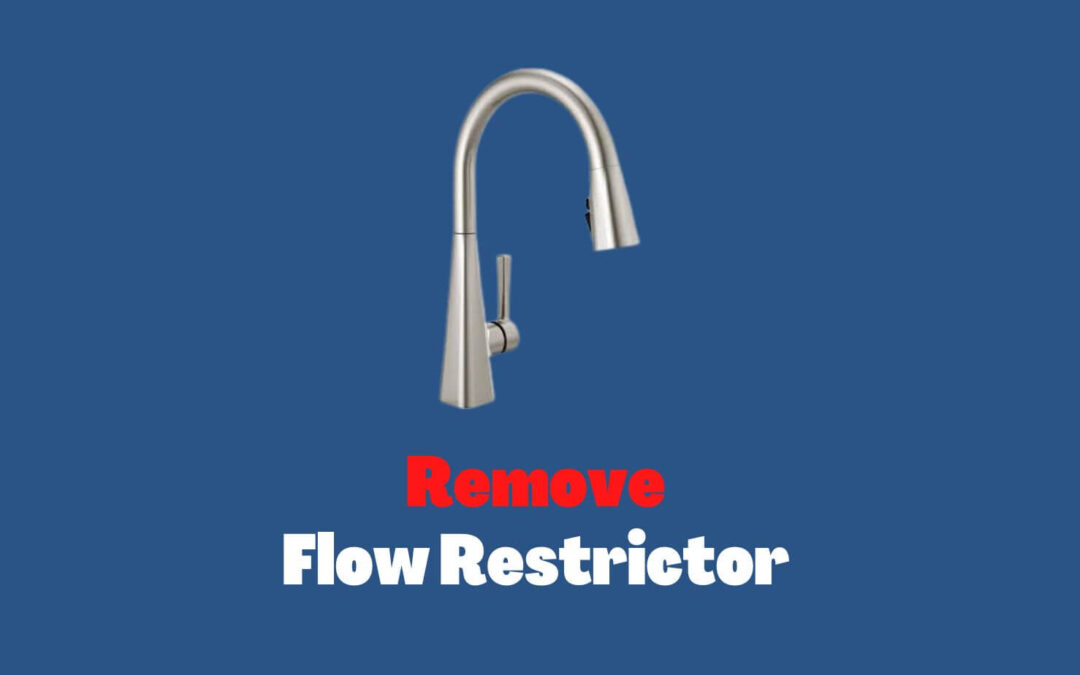Removing a flow restrictor from the delta kitchen faucet is easy, so long you follow the proper instructions. Flow restrictors help the kitchen faucet to save water since it reduces the rate of water flow, but there are some other issues related to it that make one tend to remove them.
After removing the flow restrictor, water in the faucet flows more, and there is enough pressure with water, making work more straightforward in the kitchen. Before trying to remove the flow restrictor from the Delta kitchen faucet, kindly get to know the position of the flow restrictor to avoid tampering with it. Always get a good place to keep the screws when disassembling the faucet.
The guide below provides you with the steps to remove the flow restrictor in the faucet and some questions that are always asked about the flow restrictor.
Steps of removing the flow restrictor from the Delta faucet
1. Put off any valve in the delta kitchen faucet
Any delta kitchen faucet has hot water or cold water valves below the sink. Therefore, consider putting them off before trying anything with the flow restrictor. If the valves are hidden from your sight, consider putting off the main valve to prevent water flow to the other valves. When the valves are off, there is no flow of water around, and you can check on the faucet to remove water that was initially left.
2. Locate the faucet
After closing the valves, check the faucet and open it. To open the faucet, you need to have a screwdriver that you will use to loosen all the screws holding the base of the faucet from the main tool. Some devices to use are within the delta kitchen faucet toolbox that contains some repair and replacement tools for the device if there is an emergency failure. Ensure that you open the faucet base to perform other steps carefully.
3. Check on the precautions by the manufacturer
Many components in the faucet have precautions you need to follow when working with it since the parts are delicate and can incur damage when exposed. First, ensure you have the magnetic kit to place the small parts that can easily get lost when removed. Secondly, close the sink drain if open, so the parts that fall on it do not drain to block the sink pipe.
There is an aerator in the faucet that you need to cover with tape before continuing the flow restrictor removal process. Moreover, check the manufacturer’s manual to get the instructions you need to follow when working with the faucet and the related parts.
4. Locate the flow restrictor and remove it
Before removing the flow restrictor, you must locate it in the faucet. After getting it, consider removing the aerator so you can use your hands or pliers to make work easier. After removing the aerator, remove the rubber washer to loosen the space the aerator is staying so that you can pull it.
Then, gently remove the flow restrictor from the aerator. If you need to check and replace the flow restrictor, check on some other steps below to complete the process.
5. Locate and remove the aerator
After removing the flow restrictor, remove the aerator, and kindly follow the steps. First, check the aerator to see if there is debris that accumulates inside it and remove them. Next, check the water lines also and remove any dirt particles that are inside them.
6. Change the flow restrictor.
After checking the restrictor:
- Remove any dirt particles with it that hinder the flow of water.
- Therefore, replace the flow restrictor and put everything back to place for the faucet to work.
- If the flow restrictor is still good and no dirty particles accumulate, choose to fix it back to the tap.
However, it is good to always replace the flow restrictor after some time since it can cause issues with water flow or increase water bills in the house.
Frequently asked questions
Where is the flow restrictor in a Delta kitchen faucet?
If you know flow restrictors, you can quickly know where they are in the Delta kitchen faucet. Flow restrictors are disk-shaped parts that regulate water flow out of the faucet. You need to know the position of flow restrictors so that you can easily replace them or remove debris that accumulates if your water has high amounts of minerals. There are some steps below that you can follow to get the flow restrictor in the faucet if you do not know its position:
- Check the faucet keenly to know most of its parts, including the front screen, which is the position where water comes out of the faucet.
- Using a magnetic kit, collect all the screws you will remove to get to the flow restrictor in the faucet. Remember the positions of each of the parts you are removing so you can easily assemble them.
- Remove the unit on the faucet using screwdrivers since it is mostly tight, so you cannot easily twist and remove it.
- Remove the screen that covers the flow restrictor.
- Check the flow restrictor at this point. Therefore, the flow restrictor is below the screen on the faucet.
How do I increase the water flow in my Delta kitchen faucet?
To increase the water flow in the Delta kitchen faucet, you need to follow the following steps:
- Remove all the debris that accumulates on the faucet using a washer and run water below it to remove debris behind
- Unscrew all parts below the sink bowl
- Remove the spray head and run hot water on it. If the water still runs slowly, check on the next step
- Remove the cap from the faucet and run cold water through it. Check the pressure of water such that if it is low, then check on the next step.
- Remove the flow restrictor since it regulates the flow of water. After removing the flow restrictor, I am sure the water flow will increase.
- Adjust the valves below the sink to regulate water pressure at this point to reduce water bills.
Do Delta kitchen faucets have water restrictors?
Delta kitchen faucets have water restrictors since they have their benefits to the sink. Most manufacturers fix the water restrictors in Delta kitchen faucets since most plumbing instructions are that you must have a water restrictor in the faucet. Therefore, at some point, it is not good to remove the water restrictor in the Delta kitchen for some reason.
What are the reasons for having a flow restrictor in the Delta kitchen faucet?
Flow restrictors are there in the faucet for a reason. Let’s check on some of the reasons for having the flow restrictors in the Delta kitchen faucet:
- Flow restrictors save water since it acts as a regulator in the faucet such that it works in place of the aerators, saving more water that can be wasted when the faucet is on.
- It conserves power energy such that the water that runs is regulated hence regulating the amount of power used to run the water. Remember, hot water needs more power than if it is regulated. Power is also saved.
- It increases the water pressure on the faucet with less water being used at the place hence less waste.
- Filters dirty particles that come with water such that you only get pure water without dirty particles. The flow restrictor works hand in hand with the aerator in filtering the dirty particles.
- Reduces water splash when the valves are open.
How can one replace the Delta kitchen faucet?
To install the Delta kitchen faucet, one needs to follow the steps below:
- Switch off the water flow in the valves around the sink or the main valve if the other valves are hidden, and check the faucet to ensure there is no water with it.
- Remove the initial faucet by removing all the screws holding it to the sink and the sprayer hose.
- Put a new sprayer hose to the sink before fixing the faucet
- Add the needed connector to the sprayer to tighten the connection.
- Fix the new faucet and ensure you fix back the screws as needed to the sink. Ensure the connection is tight by fixing all the screws required to the faucet and test by running water on it
Conclusion
Every kitchen owner needs to ensure that the faucet and the sink are in the right condition for all their operations to run smoothly when using them. However, there could be problems with the Delta kitchen faucet, like issues with the flow restrictor that some feel have no importance or it is causing other problems to their faucet when flowing water. The guide provides steps to follow when removing the faucet and answers your questions.
Remember, most manufacturers do not recommend removing the flow restrictor as it benefits the faucet and the user. If there are any issues with the water flow rate, try to fix other issues before removing the flow restrictor.

As the chief content writer, Hassan Al Sarker works as a professional kitchen-based content creator at Kitchen Liker.
In addition to reviewing the content published on Kitchen Liker, he ensures that it is accurate, relevant, and helpful. As a result, all the reviews and information published at Kitchen Liker are neutral and userfriendly.
Hassan Al Sarker has a bachelor’s degree in Hotel and Tourism Management From the Newyork University. Before joining Kitchen Liker, he was a contributor at Kitchen Club, United States.

